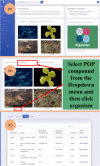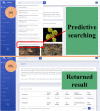mibPOPdb: An online database for microbial biodegradation of persistent organic pollutants
- PMID: 38867901
- PMCID: PMC10989864
- DOI: 10.1002/imt2.45
mibPOPdb: An online database for microbial biodegradation of persistent organic pollutants
Abstract
Microbial biodegradation of persistent organic pollutants (POPs) is an attractive, ecofriendly, and cost-efficient clean-up technique for reclaiming POP-contaminated environments. In the last few decades, the number of publications documenting POP-degrading microbes, enzymes, and experimental data sets has continuously increased, necessitating the development of a dedicated web resource that catalogs consolidated information on POP-degrading microbes and tools to facilitate integrative analysis of POP degradation data sets. To address this knowledge gap, we developed the Microbial Biodegradation of Persistent Organic Pollutants Database (mibPOPdb) by accumulating microbial POP degradation information from the public domain and manually curating published scientific literature. Currently, in mibPOPdb, there are 9215 microbial strain entries, including 184 gene (sub)families, 100 enzymes, 48 biodegradation pathways, and 593 intermediate compounds identified in POP-biodegradation processes, and information on 32 toxic compounds listed under the Stockholm Convention environmental treaty. Besides the standard database functionalities, which include data searching, browsing, and retrieval of database entries, we provide a suite of bioinformatics services to facilitate comparative analysis of users' own data sets against mibPOPdb entries. Additionally, we built a Graph Neural Network-based prediction model for the biodegradability classification of chemicals. The predictive model exhibited a good biodegradability classification performance and high prediction accuracy. mibPOPdb is a free data-sharing platform designated to promote research in microbial-based biodegradation of POPs and fills a long-standing gap in environmental protection research. Database URL: http://mibpop.genome-mining.cn/.
Keywords: biodegradability classification; database; environmental pollution; microbial biodegradation; persistent organic pollutants.
© 2022 The Authors. iMeta published by John Wiley & Sons Australia, Ltd on behalf of iMeta Science.
Conflict of interest statement
The authors declare no conflict of interest.
Figures






Similar articles
-
Dioxin- and POP-contaminated sites--contemporary and future relevance and challenges: overview on background, aims and scope of the series.Environ Sci Pollut Res Int. 2008 Jul;15(5):363-93. doi: 10.1007/s11356-008-0024-1. Epub 2008 Jul 3. Environ Sci Pollut Res Int. 2008. PMID: 18597132 Review.
-
Persistent organic pollutants in water resources: Fate, occurrence, characterization and risk analysis.Sci Total Environ. 2022 Jul 20;831:154808. doi: 10.1016/j.scitotenv.2022.154808. Epub 2022 Mar 24. Sci Total Environ. 2022. PMID: 35341870 Review.
-
The Minderoo-Monaco Commission on Plastics and Human Health.Ann Glob Health. 2023 Mar 21;89(1):23. doi: 10.5334/aogh.4056. eCollection 2023. Ann Glob Health. 2023. PMID: 36969097 Free PMC article. Review.
-
PlasticDB: a database of microorganisms and proteins linked to plastic biodegradation.Database (Oxford). 2022 Mar 1;2022:baac008. doi: 10.1093/database/baac008. Database (Oxford). 2022. PMID: 35266524 Free PMC article.
-
Exploring the role of microbes for the management of persistent organic pollutants.J Environ Manage. 2023 Oct 15;344:118492. doi: 10.1016/j.jenvman.2023.118492. Epub 2023 Jun 27. J Environ Manage. 2023. PMID: 37384989 Review.
Cited by
-
Meta-omics assisted microbial gene and strain resources mining in contaminant environment.Eng Life Sci. 2023 Aug 18;24(5):2300207. doi: 10.1002/elsc.202300207. eCollection 2024 May. Eng Life Sci. 2023. PMID: 38708415 Free PMC article. Review.
-
Ecology and risks of the global plastisphere as a newly expanding microbial habitat.Innovation (Camb). 2023 Nov 22;5(1):100543. doi: 10.1016/j.xinn.2023.100543. eCollection 2024 Jan 8. Innovation (Camb). 2023. PMID: 38111463 Free PMC article.
-
APDB: a database on air pollutant characterization and similarity prediction.Database (Oxford). 2023 Jul 14;2023:baad046. doi: 10.1093/database/baad046. Database (Oxford). 2023. PMID: 37450416 Free PMC article.
-
ICEberg 3.0: functional categorization and analysis of the integrative and conjugative elements in bacteria.Nucleic Acids Res. 2024 Jan 5;52(D1):D732-D737. doi: 10.1093/nar/gkad935. Nucleic Acids Res. 2024. PMID: 37870467 Free PMC article.
-
oriTDB: a database of the origin-of-transfer regions of bacterial mobile genetic elements.Nucleic Acids Res. 2025 Jan 6;53(D1):D163-D168. doi: 10.1093/nar/gkae869. Nucleic Acids Res. 2025. PMID: 39373502 Free PMC article.
References
-
- Guo, Wenjing , Pan Bohu, Sakkiah Sugunadevi, Yavas Gokhan, Ge Weigong, Zou Wen, Tong Weida, and Hong Huixiao. 2019. “Persistent Organic Pollutants in Food: Contamination Sources, Health Effects and Detection Methods.” International Journal of Environmental Research and Public Health 16: 4361. 10.3390/ijerph16224361 - DOI - PMC - PubMed
-
- Hung, Hayley , Halsall Crispin, Ball Hollie, Bidleman Terry, Dachs Jordi, De Silva Amila, Hermanson Mark, et al. 2022. “Climate Change Influence on the Levels and Trends of Persistent Organic Pollutants (POPs) and Chemicals of Emerging Arctic Concern (CEACs) in the Arctic Physical Environment—A Review.” Environmental Science: Processes & Impacts . 10.1039/D1EM00485A - DOI - PubMed
-
- Letcher, Robert J. , Bustnes Jan O., Dietz Rune, Jenssen Bjørn M., Jørgensen Even H., Sonne Christian, Verreault Jonathan, Vijayan Mathilakath M., and Gabrielsen Geir W.. 2010. “Exposure and Effects Assessment of Persistent Organohalogen Contaminants in Arctic Wildlife and Fish.” Science of the Total Environment 408: 2995–3043. 10.1016/j.scitotenv.2009.10.038 - DOI - PubMed
-
- Guida, Yago , Raquel Capella, and Roland Weber. 2020. “Chlorinated Paraffins in the Technosphere: A Review of Available Information and Data Gaps Demonstrating the Need to Support the Stockholm Convention Implementation.” Emerging Contaminants 6: 143–54. 10.1016/j.emcon.2020.03.003 - DOI
LinkOut - more resources
Full Text Sources
Other Literature Sources
Miscellaneous
